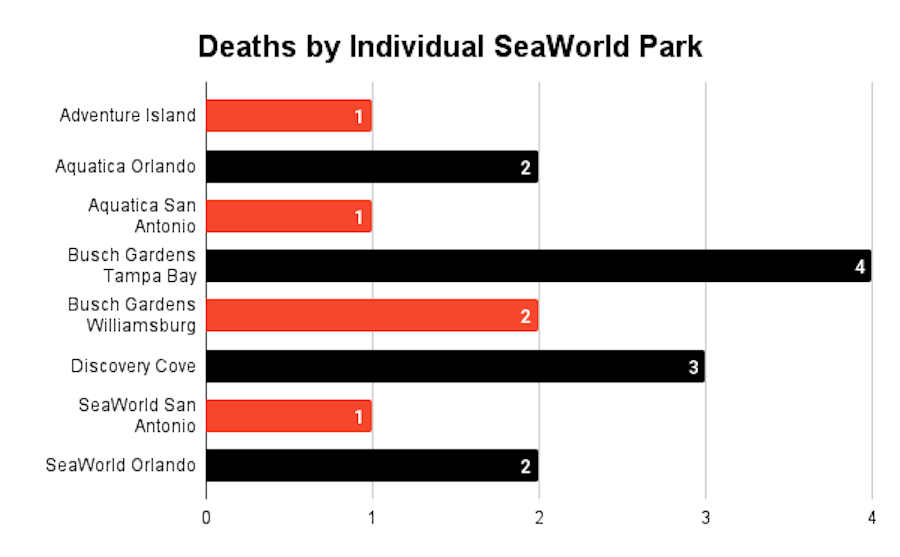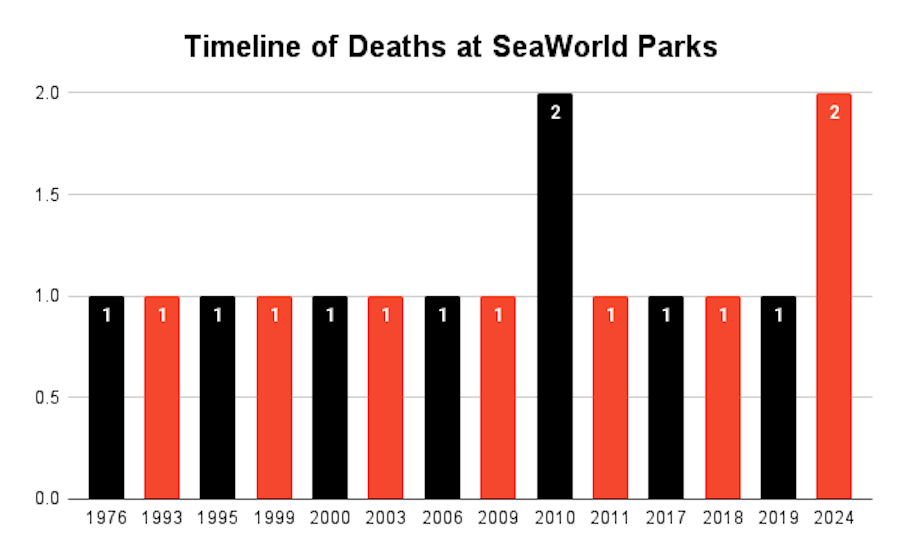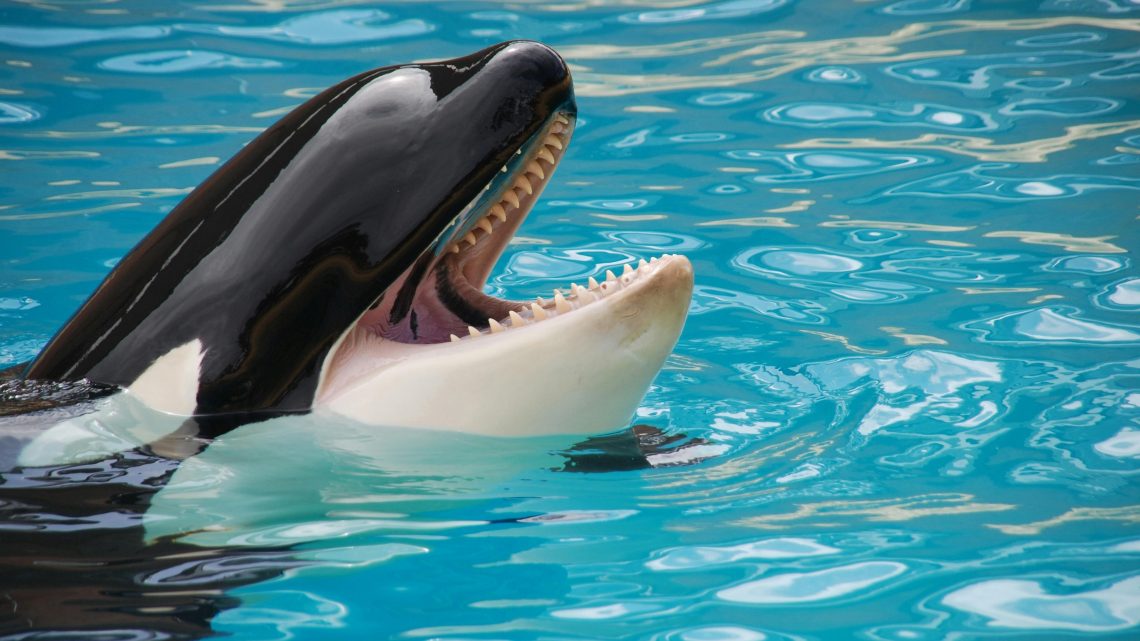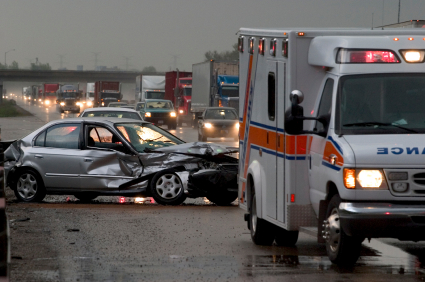With four active SeaWorld parks and several other amusement parks falling under the SeaWorld Parks & Entertainment brand, people across the world have been able to enjoy the franchise’s iconic animal encounters and other attractions. Implementing animal shows, interactive exhibits, roller coasters, and other attractions suitable for guests of all ages, the SeaWorld parks have become popular destinations for locals and tourists alike. However, despite their family-friendly nature and widespread popularity, there has been a fair share of deadly accidents at SeaWorld-owned parks over the years.
Since SeaWorld was first founded in 1964, there have been sixteen deaths at theme and amusement parks affiliated with the brand. A recent study on SeaWorld fatalities put together by Monge & Associates describes the cause of each incident in depth. Although pre-existing medical conditions contributed to many of these deaths, others occurred due to unsafe working conditions, dangerous park attractions, or even captive marine life. Read on to learn more about the deadly accidents that have occurred at SeaWorld over the years.
Which SeaWorld Park Has Had the Most Fatal Accidents?
As of August 6th, 2024, there are eight parks within the SeaWorld franchise that have had at least one human death on the premises. A graph breaking down the total number of fatalities according to the parks they occurred in is included below. To date, the park with the highest number of fatalities is Busch Gardens Tampa Bay (4). Between the four SeaWorld locations in San Antonio, Orlando, San Diego, and Abu Dhabi, there have only been three recorded deaths.

Timeline of SeaWorld Deaths
Even though SeaWorld first started as a franchise in 1964, there were only four fatal incidents connected with the chain’s parks in the 20th century. The remaining twelve deaths associated with SeaWorld parks occurred between 2000 and 2024. Throughout the franchise’s history, there have only been two years where two or more fatalities occurred in the span of a calendar year: 2010 and 2024. In 2010, there was a fatal orca attack at SeaWorld Orlando and a death of natural causes at Aquatica Orlando. In 2024, there were a pair of drownings at Discovery Cove, just two months apart. The graph below displays a timeline of fatalities at SeaWorld facilities.

Which Attractions & Rides Caused the Most Deaths at SeaWorld?
Theme parks have many hidden dangers that visitors and employees may not consider daily. Dangerous or defective rides, inattentive employees, improperly maintained premises, and other hazards can put people at risk of serious injury or death. In some cases, pre-existing medical conditions and environmental factors can significantly increase the chances of an adverse outcome. In this article segment, we discuss some of the leading causes of death at SeaWorld facilities.
Discovery Cove
To date, three deaths have occurred due to Discovery Cove’s water attractions. The first incident is perhaps one of the most shocking to occur at any SeaWorld park. On January 29th, 2009, a man suffered what would end up being fatal harm when he cut his toe on some coral while swimming with fish at Discovery Cove. The victim, who was a hemophiliac, suffered blood poisoning that led to septic shock and organ failure. Doctors amputated both of the victim’s legs below the knees in an attempt to prevent infections, but the man perished from multi-organ failure approximately eight weeks after he was initially hurt.
There were an additional pair of drownings at Discovery Cove just two months apart, in May and July of 2024. In one case, a 13-year-old girl drowned after experiencing difficulty in the water. The second victim was found unresponsive in the pool shortly before 10:00 a.m. and was pronounced dead at the hospital later that day.
Orca Attacks
Over the years, SeaWorld has been in the spotlight repeatedly for their alleged mistreatment of the animals under their protection, most notably the franchise’s captive orcas. The 2013 documentary Blackfish highlights the controversies of keeping orcas captive and the tragic consequences of such creatures being kept in captivity. The captive orca Tilikum was responsible for both of the deaths that occurred at SeaWorld Orlando to date. Over the course of his life, Tilikum killed three people in total. Two of his victims were trainers and one was a homeless man who snuck into the whale’s enclosure after the park closed. The first death caused by Tilikum occurred at Sealand of the Pacific, leading to its exclusion from the initial study put together by Monge & Associates.
Four people in total have been killed as a result of an interaction with a captive orca. There has never been a confirmed case of a wild orca attacking and killing a human, although a surfer in Point Sur was attacked by a whale that may have mistaken the victim for a sea lion. The victim survived the encounter, as the whale quickly released the man once it realized its mistake. The heightened aggression demonstrated by orcas in captivity towards humans showcases the inherent risk of using such majestic creatures in shows and attractions.
Roa’s Rapids
Roa’s Rapids is a fast-paced version of a lazy river, where visitors are whisked downstream by a brisk current that carves its way down a series of man-made channels. The river ride is one of the more popular attractions at Aquatica Orlando, which boasts many attractions suitable for park guests of all ages and swimming levels.
To date, two park guests have lost their lives in incidents connected to Roa’s Rapids. On October 4th, 2010, a 68-year-old tourist from Manchester was found unresponsive in the water. He was immediately transferred to Dr. Phillips Hospital but did not recover. Several years later, another park guest lost their life on the same ride on July 15th, 2017. A 58-year-old man with a history of seizures and strokes became unresponsive while in the water. He was a resident at a nursing home that was on vacation with thirteen other residents and a nursing assistant. The victim’s cause of death was determined to be drowning, albeit influenced by additional factors.
Big Bad Wolf
The Big Bad Wolf is a suspended roller coaster that was in operation at Busch Gardens Williamsburg from 1984 to 2009. During the course of the ride’s operation, two employees were killed in separate incidents involving the attraction.
On May 2nd, 1993, a maintenance worker was killed when he attempted to perform repairs to the ride while it was still active. The victim’s family stated that he was sent into a restricted area of the ride to clear a branch restricting the vision of one of the ride’s security cameras. The victim’s family attempted to sue the park in the aftermath of the tragic incident but was unable to do so due to a state law preventing the recovery of civil damages for work-related injuries.
On March 1st, 2003, a second worker was killed while working on the same attraction. The worker was using a high-reach vehicle to paint the ride when the vehicle overturned. James City County first responders confirmed that the victim was deceased when they arrived at the scene of the incident.
Staying Safe at SeaWorld Parks
Although SeaWorld parks are generally safe for visitors of all ages, there are some actions you can take to ensure you and your family have an enjoyable, stress-free experience. When you visit SeaWorld or any other theme park, be sure to stay hydrated and out of the sun as much as possible. Obey park employees and signage and never venture into restricted areas of the park. If you or anyone in your party has dietary restrictions, physical limitations, or another condition that impacts general health, be mindful of how certain rides and attractions may not be safe for the person in question.
We hope that this research helps franchises, such as SeaWorld, continue to improve upon their safety protocols to protect visitors and guests alike upon their premises. Deaths at amusement parks such as Six Flags, Disneyland, and SeaWorld are tragic occurrences that can hopefully be better prevented in the future.





No Comment